These beautiful botanical illustrations here are all from the book “Temple of Flora, or, Garden of the botanist, poet, painter, and philosopher” by Robert John Thorton 1812.
There are only about 800 copies of this renowned and rare flower book. Each copy of the Temple of Flora contains 31 plates accompanied by inspirational poetry and explanatory notes covering flower lore and legend.
A variety of methods from aquatint, engraving and stipple were used to make the beautiful flora plates. Before they were printed in colour and hand-finished.
This laborious way of producing the plates was very costly. Thorton had to resort to a public lottery to fund the painting of the plates. Unfortunately, the lottery failed and Thorton faced financial ruin. His family was almost destitute when he died in 1837.
The Temple of Flora is now considered one of the most prized vintage flower books. Thornton (1768-1837) trained first as a doctor at Cambridge University before becoming a botanical writer.
The plates are unique combining exotic and beautiful plants with romantic background landscapes linked to the flowers. Each plate is accompanied by descriptions in suitably flowery prose, selections of floral poetry, accounts of flower lore and symbolism, and other information.
The botanical illustrations are more artistic in style than they are scientific, they remind me of the beautiful still life flower paintings of the 17th-century Dutch masters.
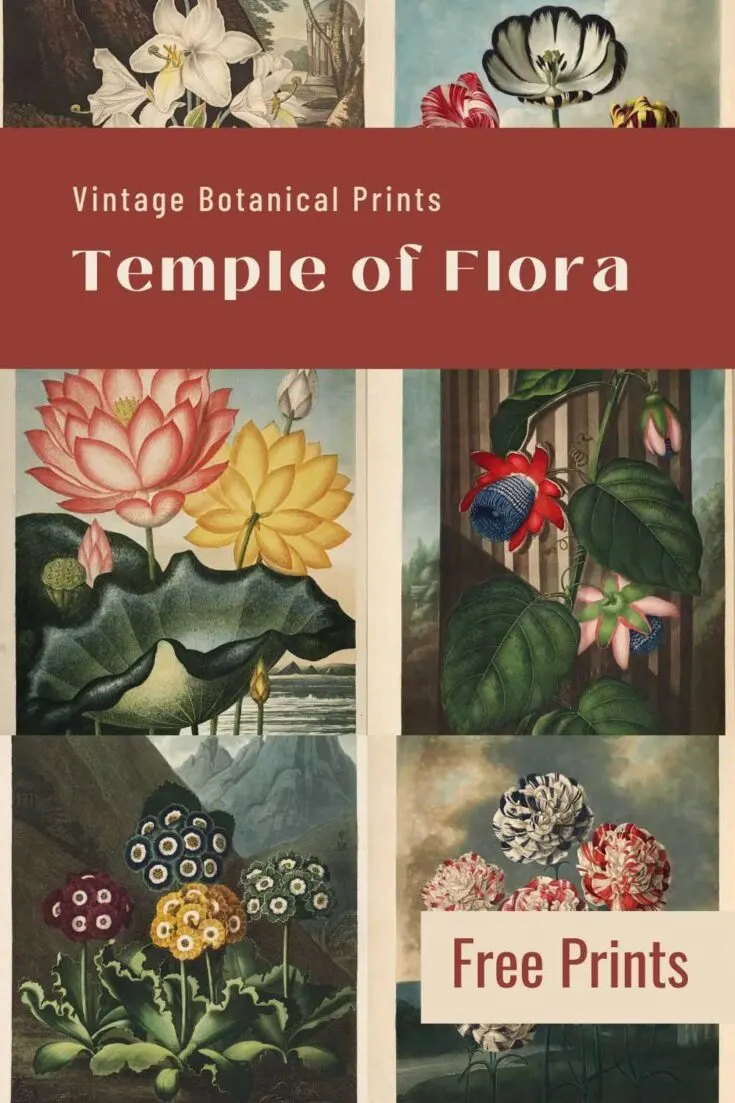
The Temple Of Flora Prints
Click on the title above the floral print you want to download. A higher resolution image of that print will open in a new window in your browser. Click on that image to save or printer.
The book is in the Public Domain, so all the prints here are copyright free.
I’ve included a small paragraph of descriptive text from the book with each vintage floral print.
1. Cupid Inspiring Plants With Love
This painting of Cupid inspiring plants with love in a tropical landscape is at the beginning of the book. It is accompanied by a poem by George Dyer.
Teeming with Nature’s lively hues, I bid thee welcome, genial spring!
While fancy wakes her thousand lyres, And woods and vales responsive sing…
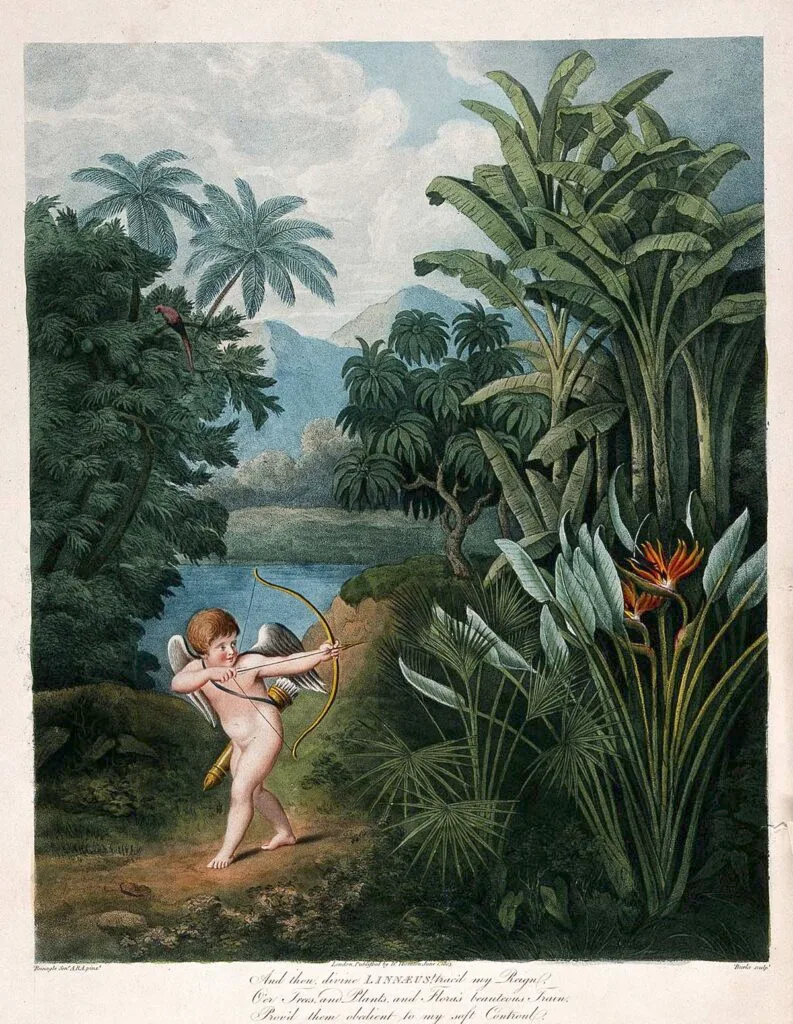
2. Persian Cyclamen
The Persian cyclamen is a flowering herbaceous perennial plant. It is native to rocky hillsides, shrubland, and woodland, from south-central Turkey to Lebanon-Syria and the Palestine region.
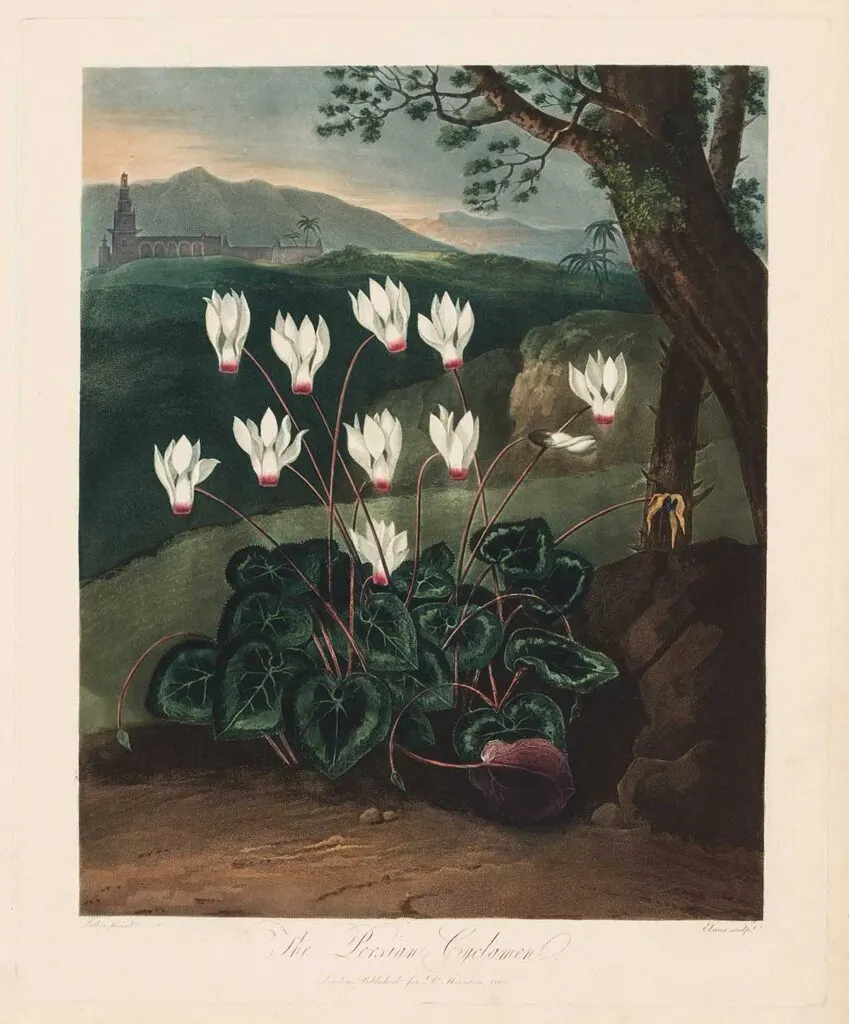
3. The Snowdrop
“The first flower that appears on the verge of winter is the Snow-Drop, of a pale white, with a little green in the three central petals, whose form the poetess thus elegantly depicts.”
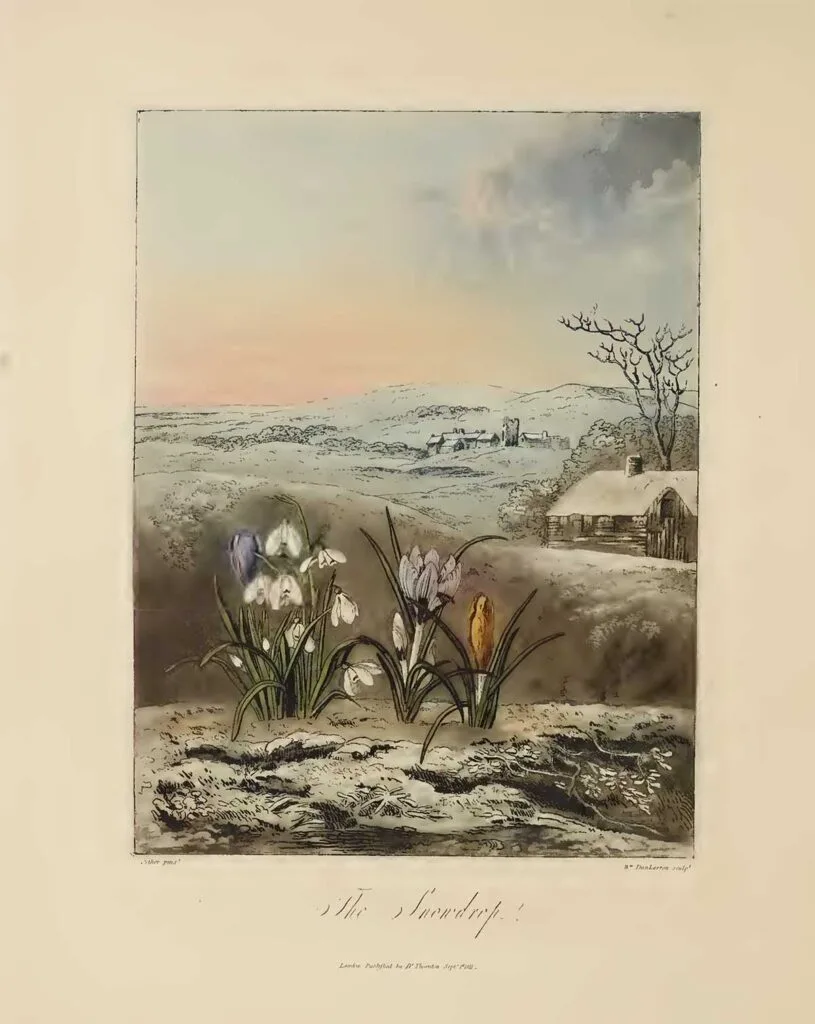
4. A Group of Roses
A painting of a group of roses from the Temple of Flora. There are nesting birds among the roses and dragonflies.
“As Spring advances, the flower of the greatest beauty appears, the Rose, equally prized in every quarter of the globe, which in its wild state has five heart-shaped petals of a delicate blush, and beautifully veined, a calyx of singular construction, being urn-shaped, and the upper part shooting out into five rays, or segments, whereof three of them are beautifully fringed“.
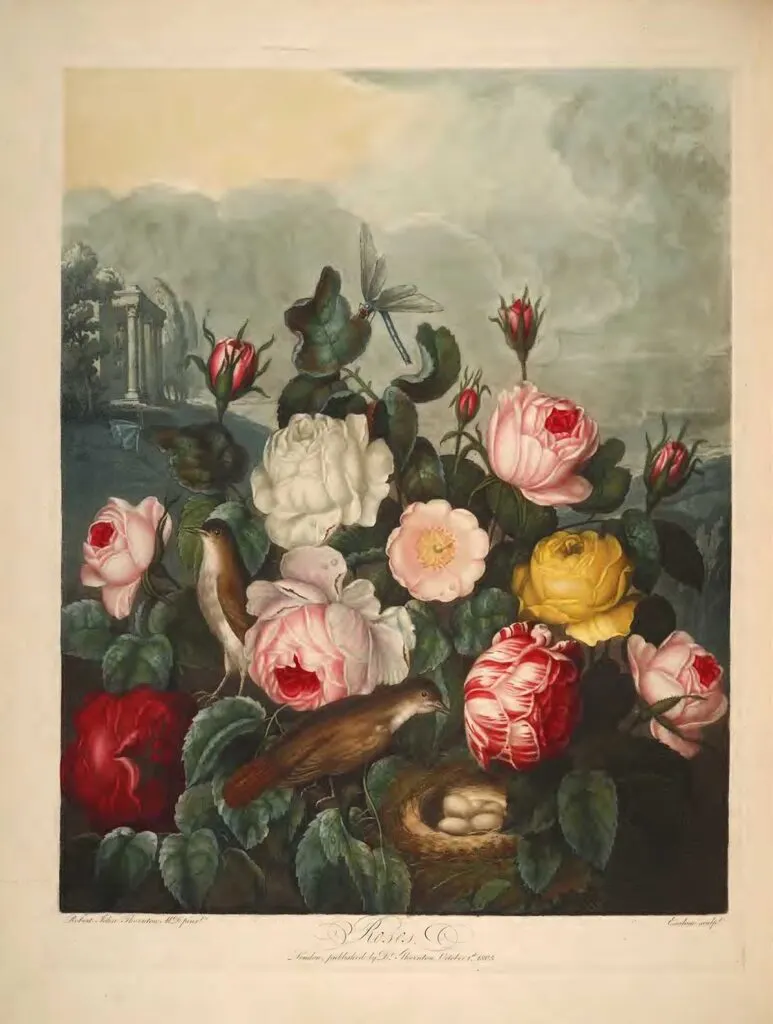
5. A Group Of Hyacinths
“This plant, like most of the others of Spring extraction, in its wild state, hangs down its azure bells, and having a delightful scent, is one of the most agreeable gifts that Providence has bestowed upon mortals.“
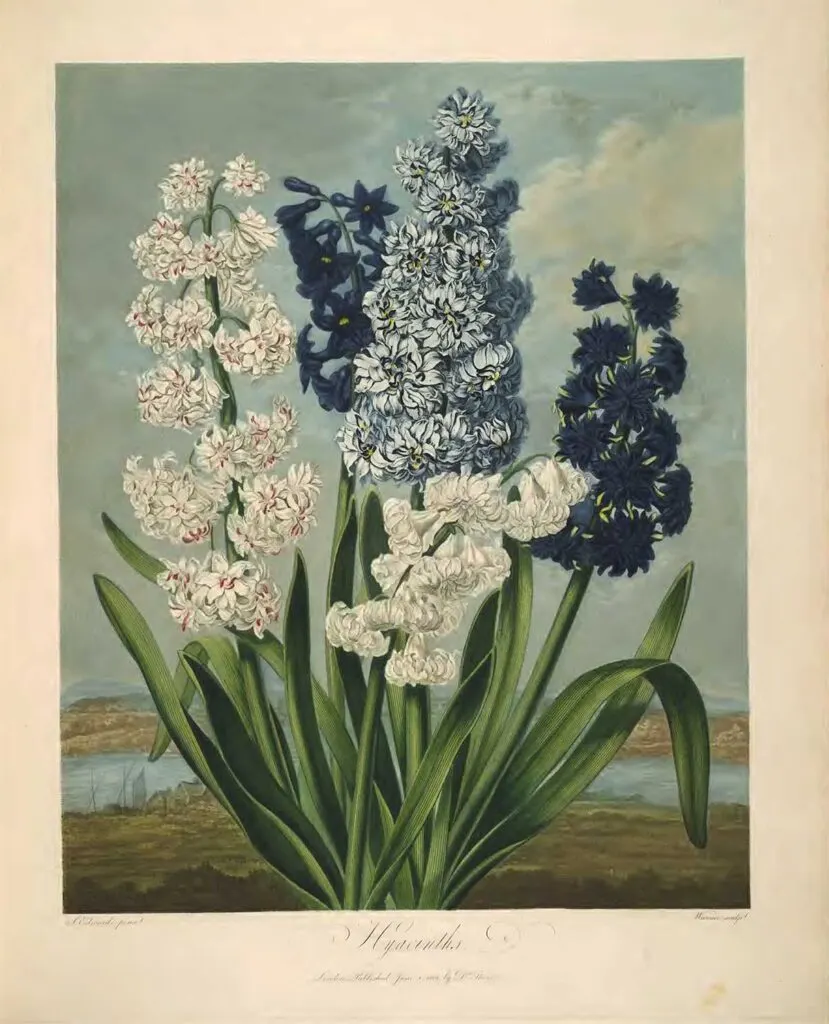
6. A Group of Auriculas 1
“Being a native of the Alps, hence, in our Picture, it is seated near a chain of tremendous mountains. It is called by old Parkinson the Mountain Cowslip, also the Bears-ear; the latter name from its leaves, which are fleshy, and round at the top, being thought to resemble the ear of that animal. Its flowers are in an umbel, placed upon a fleshy, upright, scape; and Nature, in her bounty, has provided here a general involucre, which is a strong serrated leaf, often raised aloft like a banner, at the back of the flowers, so as to receive the shocks from the winds, which otherwise would dash them against the mountain’s side“
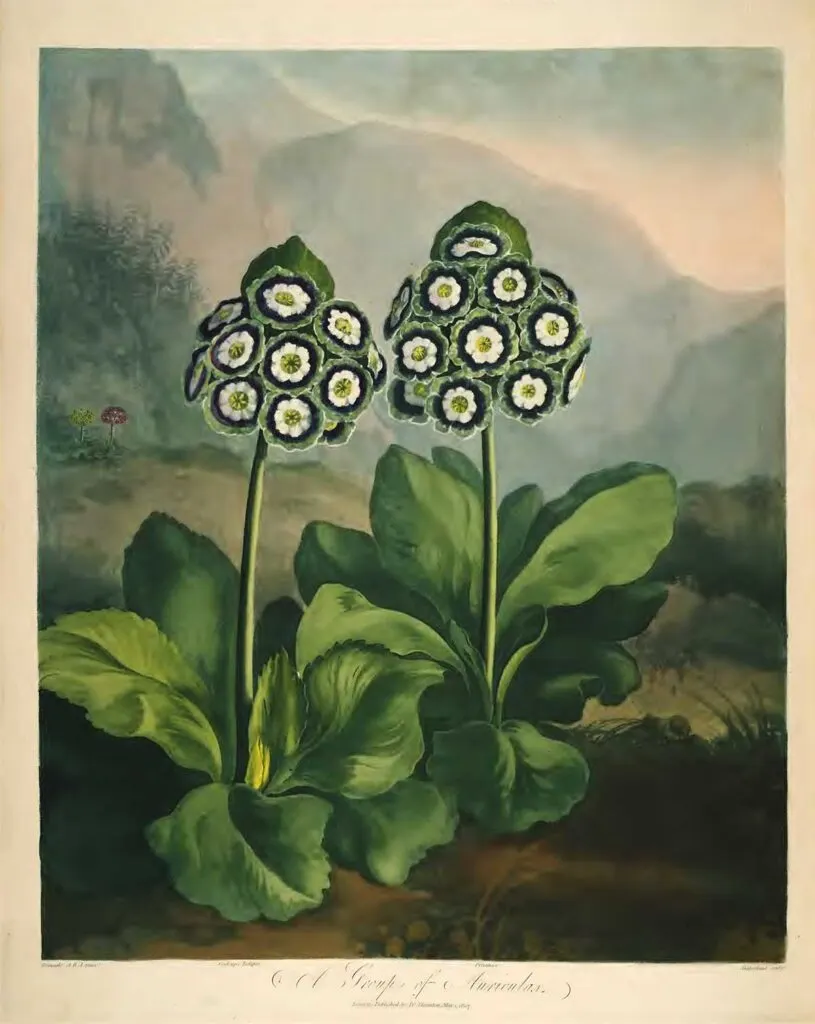
7. A Group of Auriculas 2
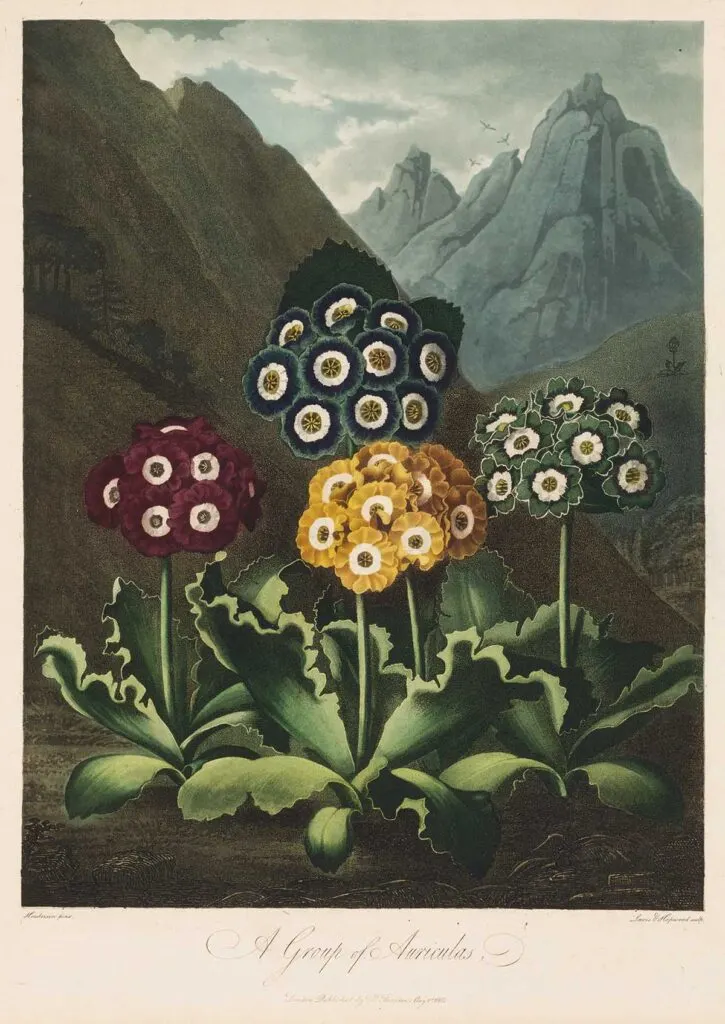
8. A Group Of Carnations
A group of colourful carnations from the Temple of Flora, described as follows:
“The Carnation, so deservedly esteemed both for its superior beauty and rich spicy odour,* must certainly have been unknown to the ancients, or it would have been described by naturalists as the rival of the Rose, and as such sung by poets. In its wild state, it has five small red petals, and attracts no notice from its beauty, nor has it in that state any scent.”
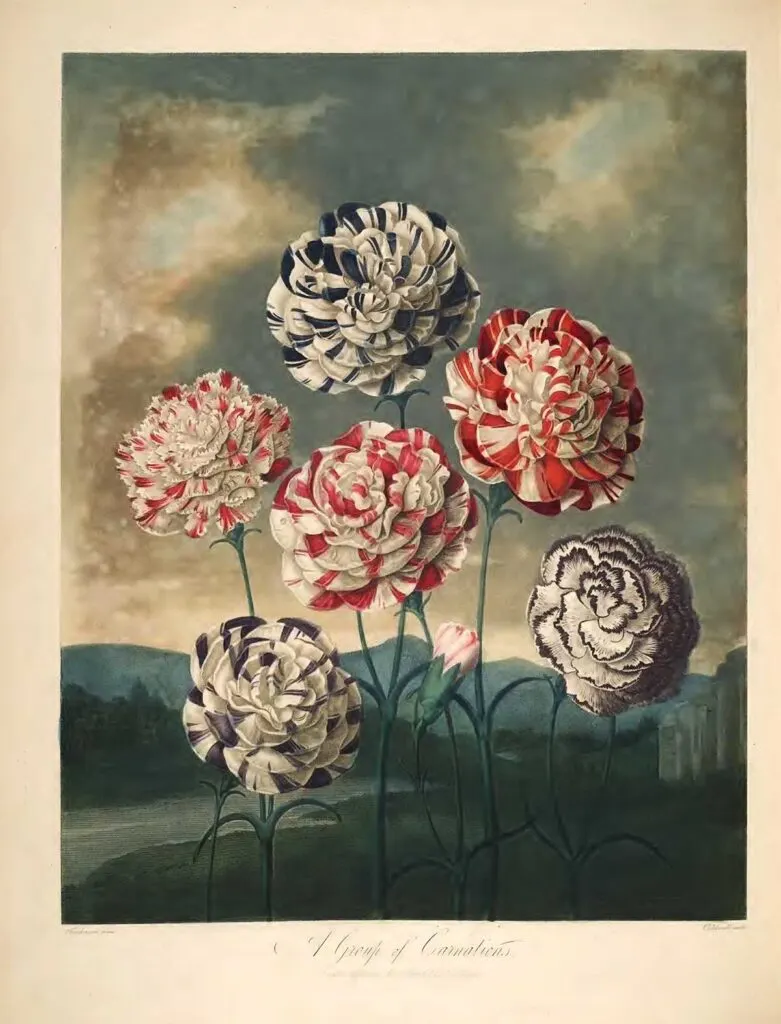
9. A Group Of Tulips
This painting of tulips is set in a Dutch landscape, a windmill can be spotted in the background.
“As each individual Tulip shows a marked variety, so when grouped together, you have a striking display of the wonderful power of the beneficent Creator, who has placed these beautiful objects before us, for our recreation, and admiration.”
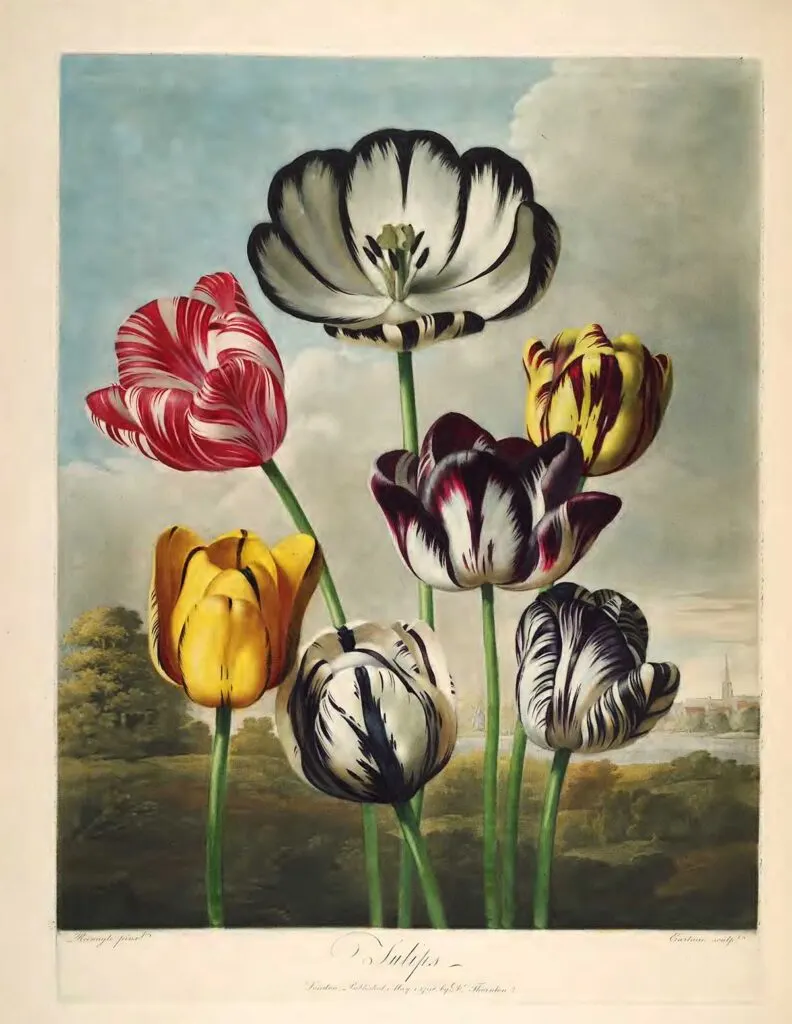
10. Queen Plant
“This is one of the many lovely productions imported from the Cape of Good Hope, introduced into our gardens by Sir Joseph Banks, Bart. K.B., the illustrious and most indefatigable promoter of the science of Natural History. Its leaves are coriaceous and spoon-shaped, often undulated at the base, inwardly of deep green, and outwardly beautifully glaucous. The flowers are of a bright orange, tripetalled, enclosed at first by two long membranous calyx leaves, which drop as the flower rises from the common spatha, and these appear in succession, each retiring backwards, to give place to other flowers.“
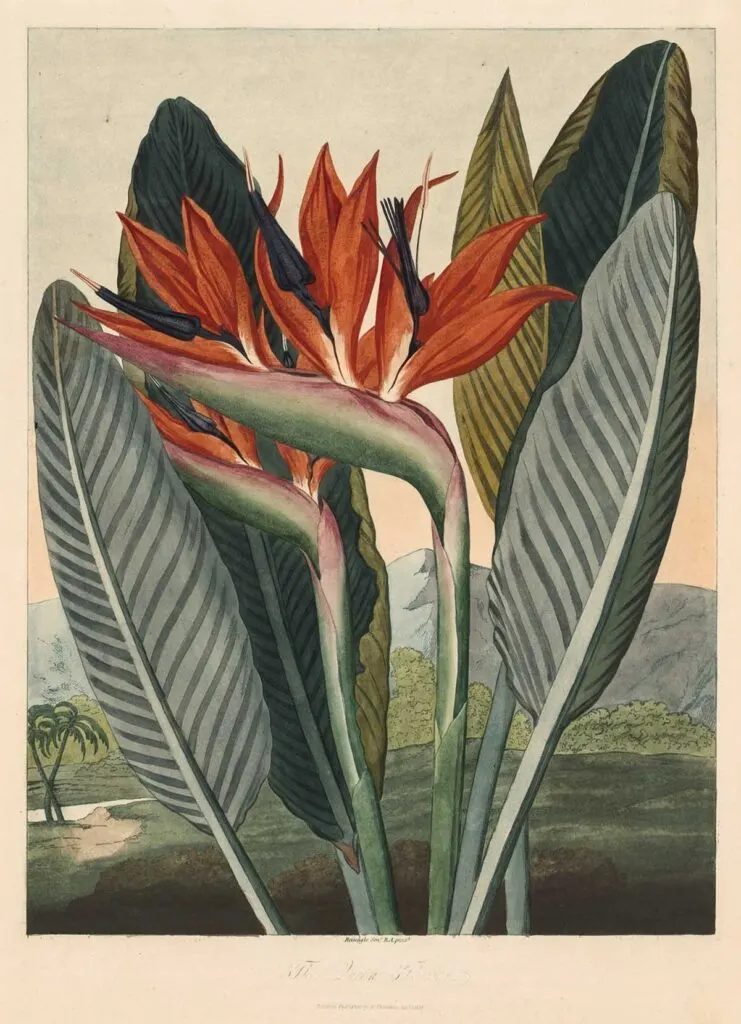
11. American Aloe
“Parkinson, who lived in 1640, mentions the Aloe as being brought from South America into Spain. In 1690, the Aloe is represented to have flowered at Lambeth, and two other plants in 1714, at Hampton Court Palace. The Aloe from which our representation was taken, flowered in the month of September 1790, at Smith’s nursery, at Dalston, near Hackney.”
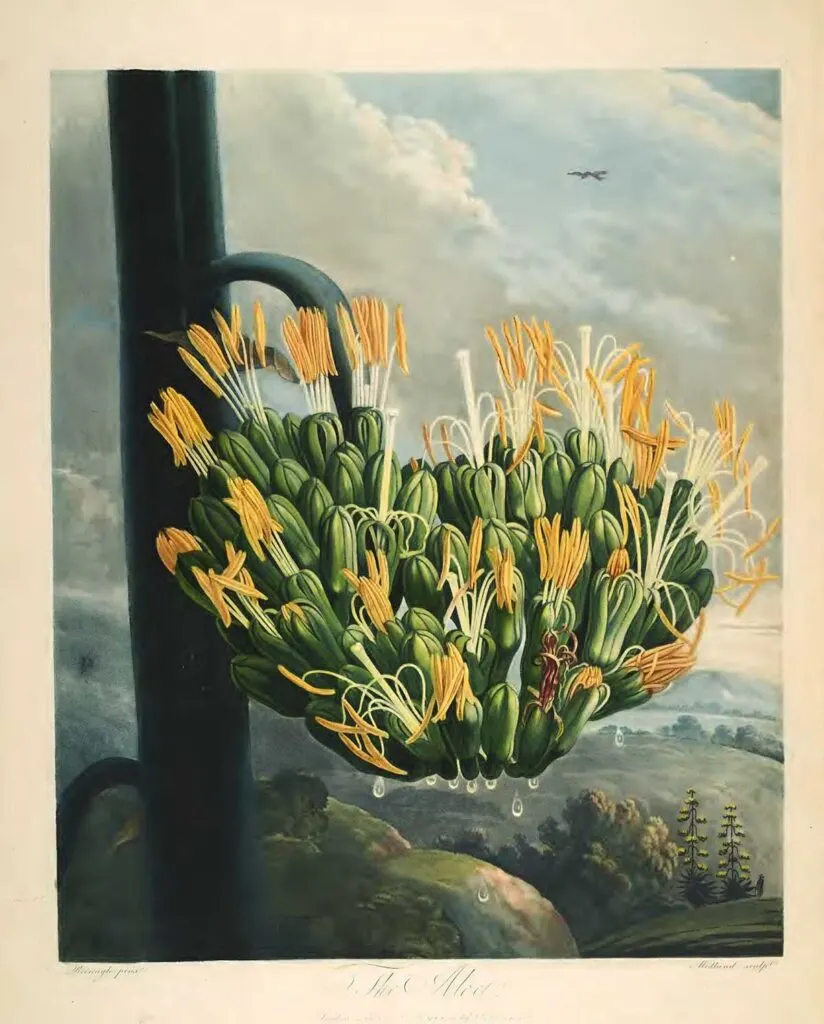
12. Nodding Renealmia – Temple of Flora
“This lovely Tree rises by the banks of rivers to the height of near twenty feet. Its leaves are alternate, strongly veined in the midrib exteriorly, but channelled on the inside. Like the Indian Canna they constitute a part of the stalk. In its first stage, the buds are enveloped within a leafy sheath, in the centre, supporting at its top a small leaf. The inside is of a beautiful crimson. The flower then shoots out a real spatha consisting of two leaves of light green, elegantly running into crimson.“
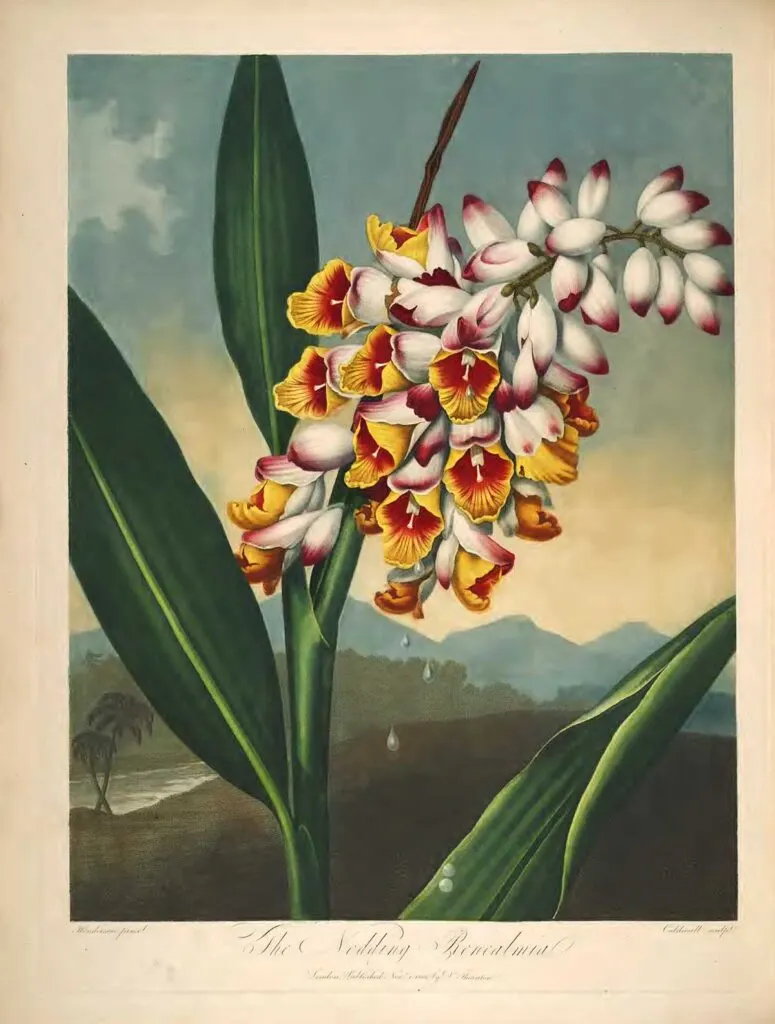
13. Night Blowing Cereus
“This plant is called by Linnaeus large-flowering Cactus, on account of the comparative largeness of its flower, which, in its native country, Jamaica, is often more than a foot in diameter. It has the appellation also of Night-blowing Cereus from its opening and its beautiful flowers after sunset. Others have styled it the Thorch Thistle, from the armature about its pentangular, articulated, and climbing stem, which is leafless, succulent, and exhibits to the observer a figure equally grotesque as terrific, with flowers possessing actually the blazing appearance of a torch.“
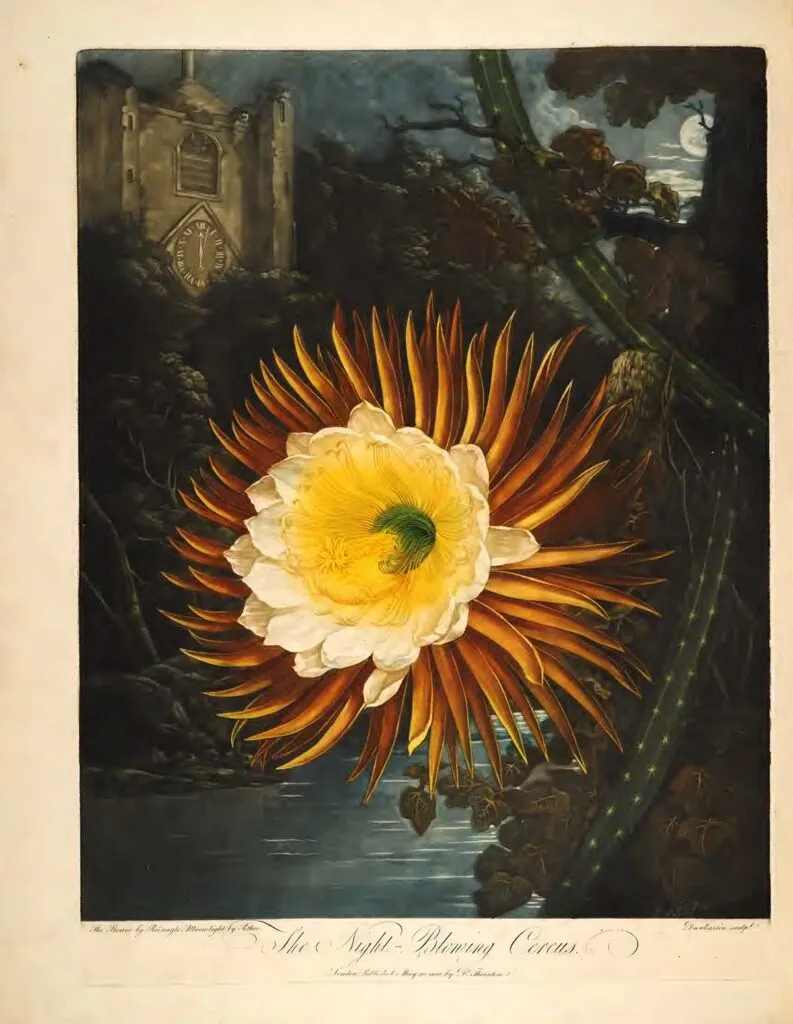
14. Oblique-Leaved Begonia
An illustration of a begonia plant with butterflies, from the Temple of Flora.
“The oblique-leaved Begonia is a native to America and was introduced into our hot-houses in the
year 1777, by Dr William Brown. This ornamental shrub, which rises from three to five feet
has numerous leaves, oblique, very smooth, laterally heart-shaped, waved, and terminating acute Its
flowers afford a beautiful example of the Sexes of Plants, being male and female.“
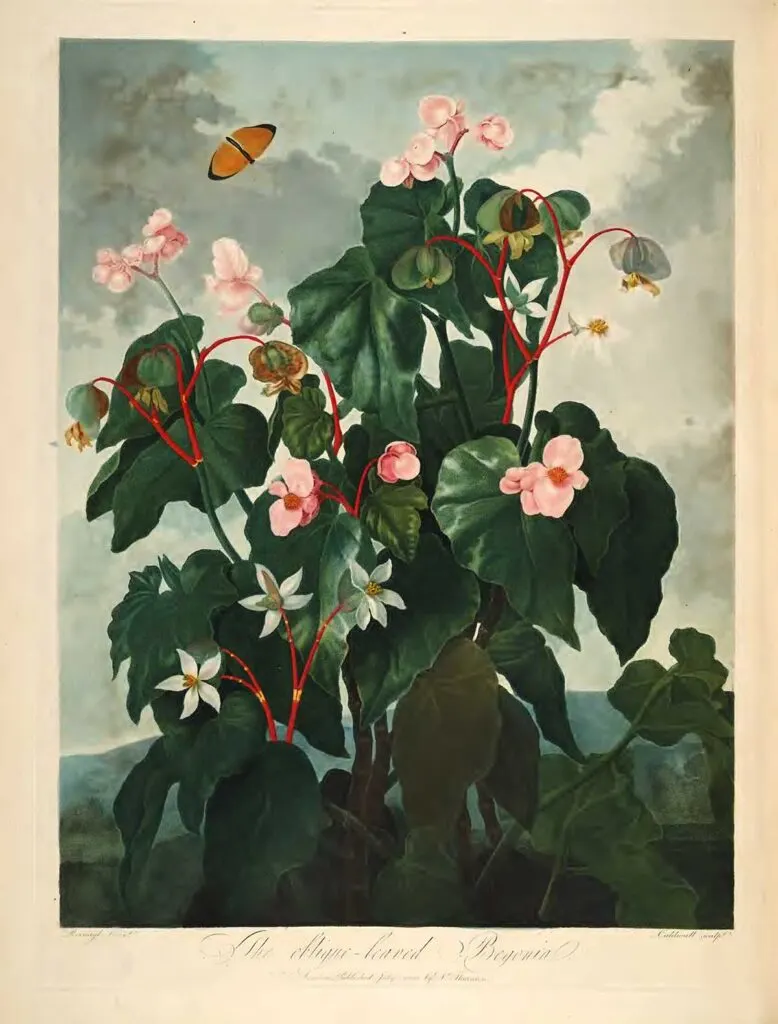
15. Mimosa Grandiflora
A beautiful painting of a mimosa grandiflora and hummingbirds.
“This beautiful shrub is native to both the East and West Indies. It was introduced into our gardens in 1769, by Mr Norman. Found frequently in the mountains of Jamaica: hence one of the aborigines gazing at and admiring its flowers. It sleeps at regular periods by closing its two corresponding leaflets together; and the flowers are so rapid in their growth, as to give to them also the appearance of spontaneous motion, Nature having well dissembled in this tribe of vegetables the high attributes of sensation, and of action.“
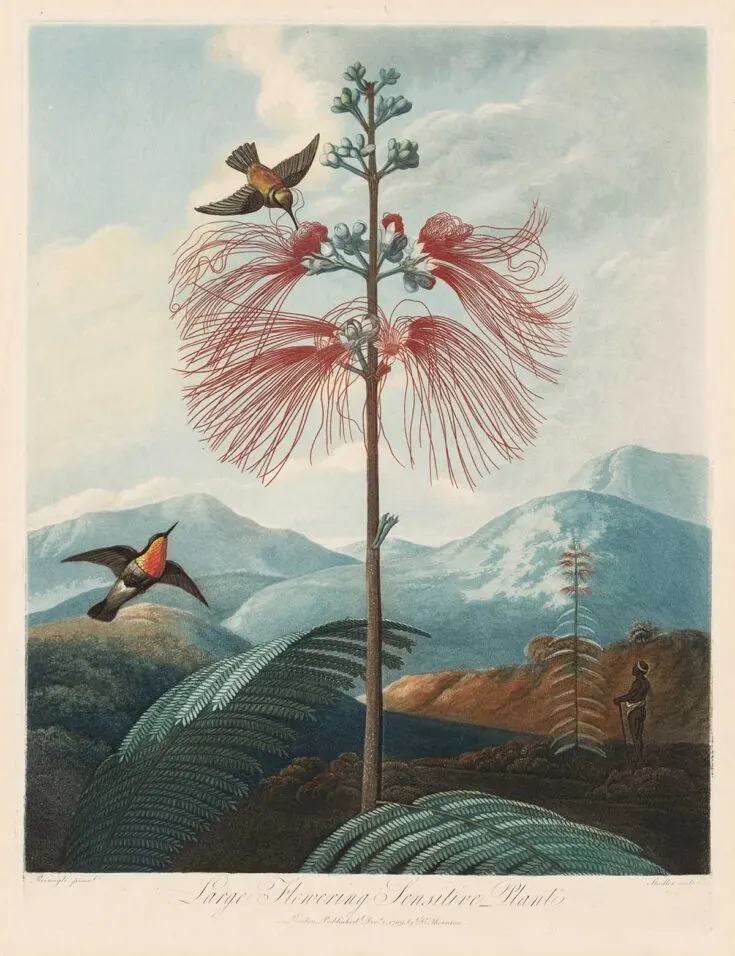
16. Common Blue Passion Flower
The passion flower has religious associations, which are described by Robert Thornton in the Temple of Flora below.
“All the Passifloras claim the admiring eye, nor is this, though the most common, as thriving well out of doors, the least attractive. It was discovered in the Brazils, and its wonders were soon proclaimed to Christian kingdoms as representing the Passion of our Lord, whence its pre- sent appellation. The leaves were said exactly to resemble the spear that pierced our Saviour’s side; the tendrils, the cords that bound his hands, or the whips that scourged him; the ten petals the apostles, Judas having betrayed, and Peter deserted; the pillar in the centre was the cross or tree; the stamina, the hammers; the styles, the nails; the inner circle about the central pillar, the crown of thorns; the radiance, the glory; the white in the flower, the emblem of purity; and the blue, the type of heaven.”
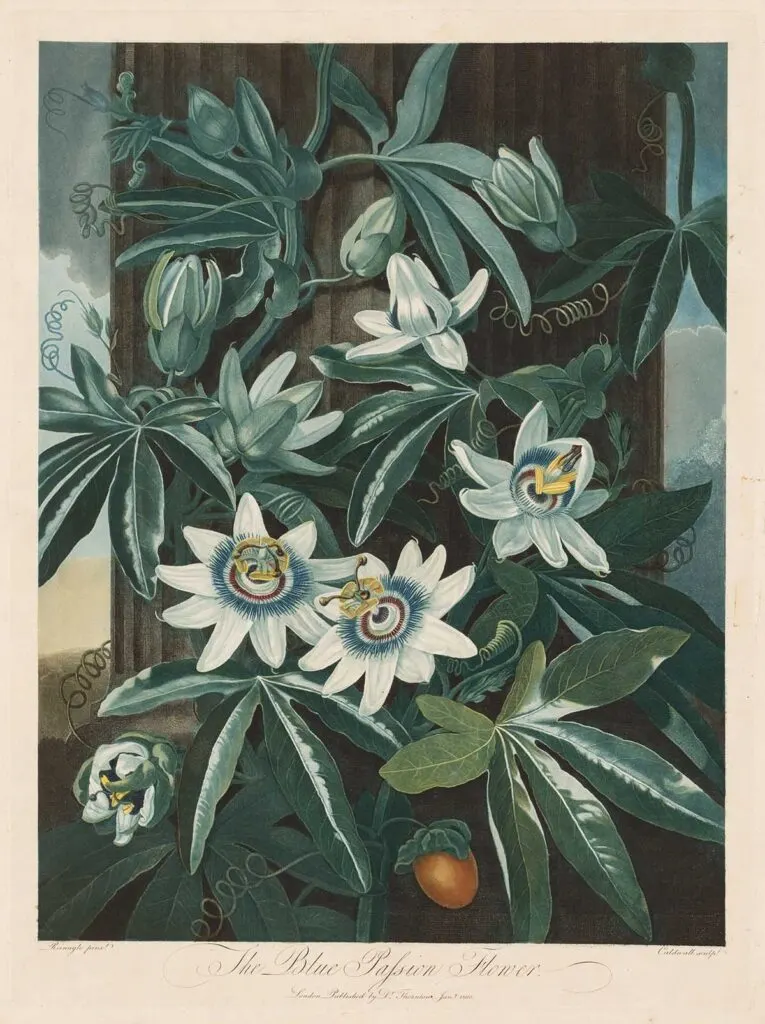
17. The Winged Passion Flower
“Elegantly hanging on its peduncle, or footstalk, the Alata Passionflower far surpasses all its kindred both as to the elegance and brilliancy of its appearance. It exhibits much more of majesty than the rest, and discloses a trait in nature which has often puzzled shallow philosophers.“
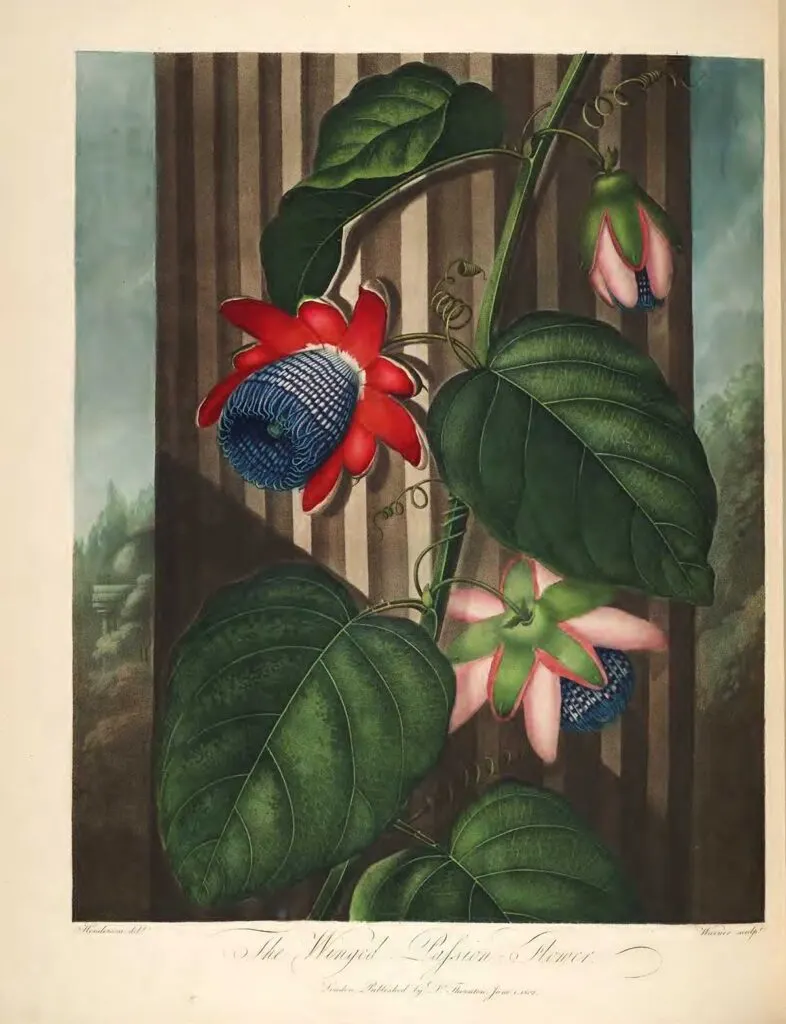
18. The White Lily
“The White Lily with variegated leaves is native of Persia, where it majestically presents its finely-polished bosom to the all-enlivening sun, the object of worship in eastern nations. How contrasted is this flower with our humble Lily of the Valley, which even hides its delicate pendulous head from the feeble rays of the spring! The White Lily has, however, like all other lilies, a corolla (or nuptial bed), consisting of six petals, three inward and three outward.”
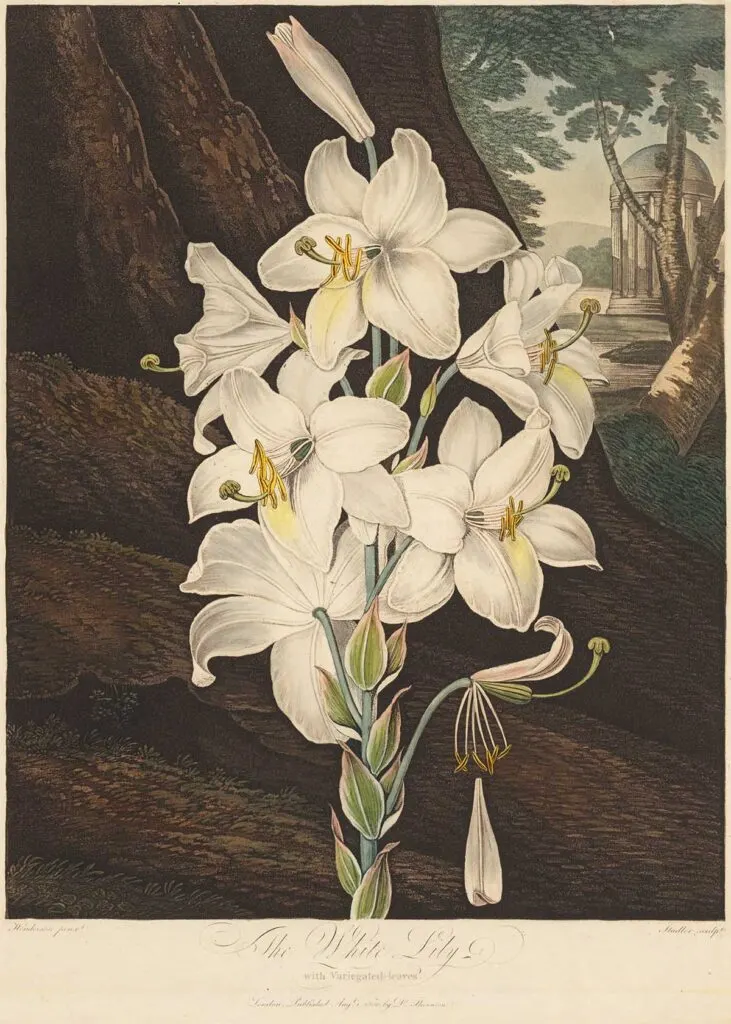
19. The Superb Lily
“The Superb Lily is a native of North America and was first introduced into England in 1738, by Peter Collinson, Esq. It was then called the great yellow-flowering Martagon, and distinguished from the purple, or common Turkscap, by having its leaves scattered, instead of being placed in a whorl. Its flowers rise in the form of a stately pyramid by a very long peduncle, or footstalks, each issuing from the axilla of the stem leaf.“
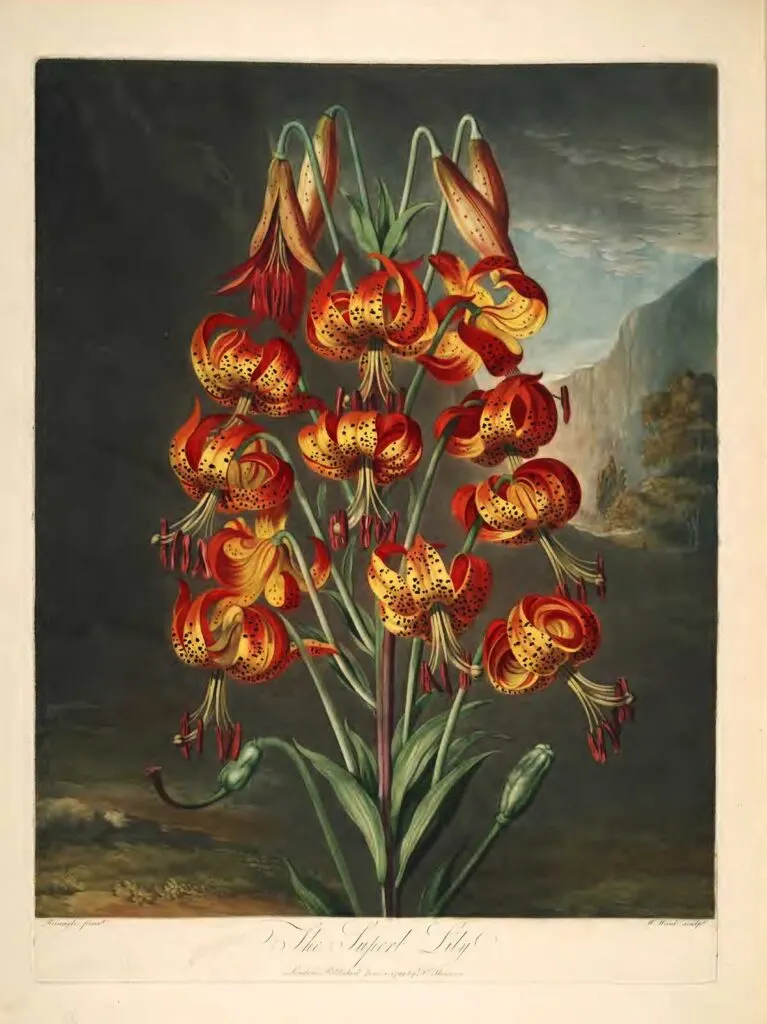
20. The Dragon Arum
“This extremely foetid poisonous plant will not admit of sober description. Let us, therefore, personify it.
She comes peeping from her purple crest with mischief fraught: from her green covert projects a horrid spear of darkest jet, which she brandishes aloft: issuing from her nostrils flies a noisome vapour infecting the ambient air: her hundred arms are interspersed with white, as in the garments of the inquisition; and on her swollen trunk are observed the speckles of a mighty dragon: her sex is strangely intermingled with the opposite! t confusion dire! — all framed for horror; or kind to warn the traveller that hex fruits axe poison-berries, grateful to the sight but fatal to the taste, such is the plan of Providence, and such her wise resolves.”
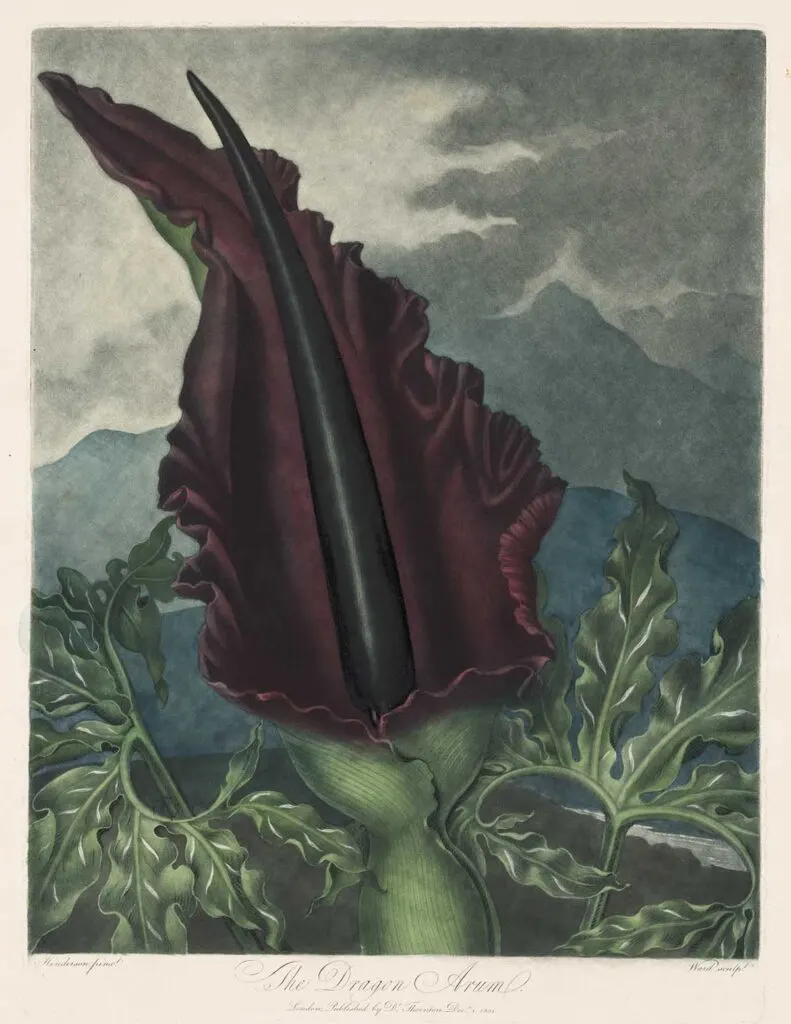
21. The Pontic Rhododendron
An beautiful painting of a purple Rhododendron flower surrounded by insects, from the Temple of Flora..
“In the dreary season of winter, nature has partially indulged the eye with ever-greens, the presage of the resurrection of animated beings, and of the returning zephyr; and none of this class claims our attention, for the beauty of its flowers, and wisdom of its contrivance, more than the Pontic Rhododendron, which was introduced into our gardens from the Levant in 1763.“
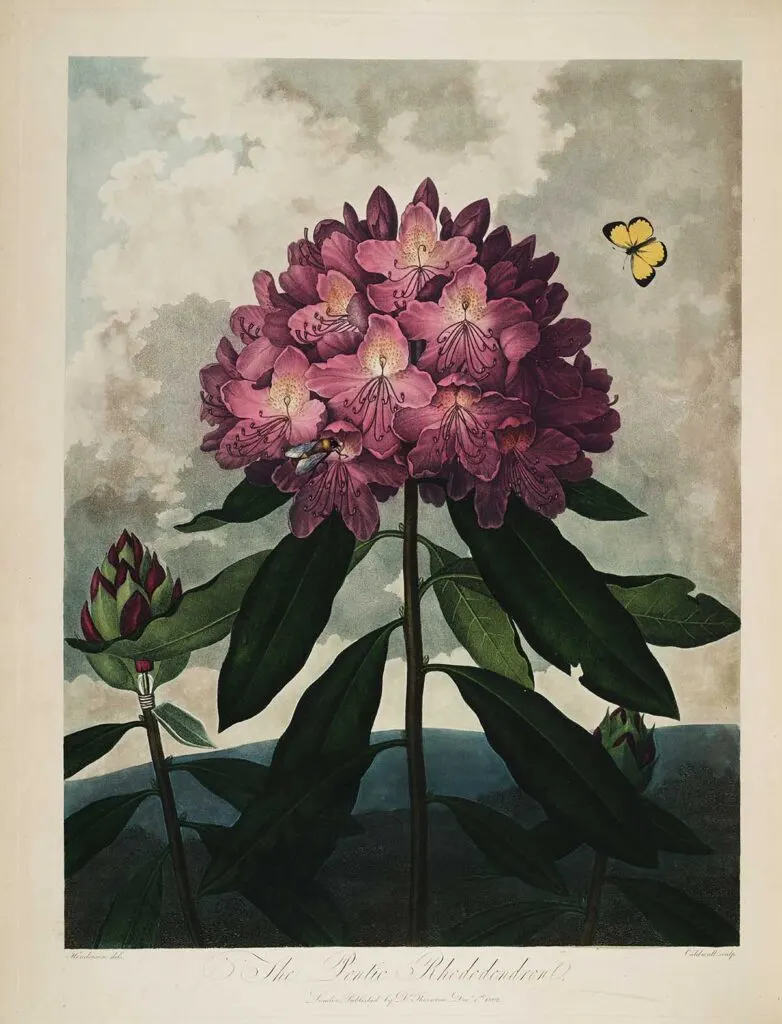
22. American Cowslip
If you look closely, there are two sailing ships painted in the background.
“It has its present appellation from its native country, and from the resemblance its growth bears to the ordinary Cowslip, possessing, like it, leaves radical, and an erect scape or flower stem. From the summit of the scape, which is fringed round with numerous small and regular leaves, the peduncles or flower stalks, as in umbelliferous plants, issue in every direction, each bearing a very beautiful flower.“
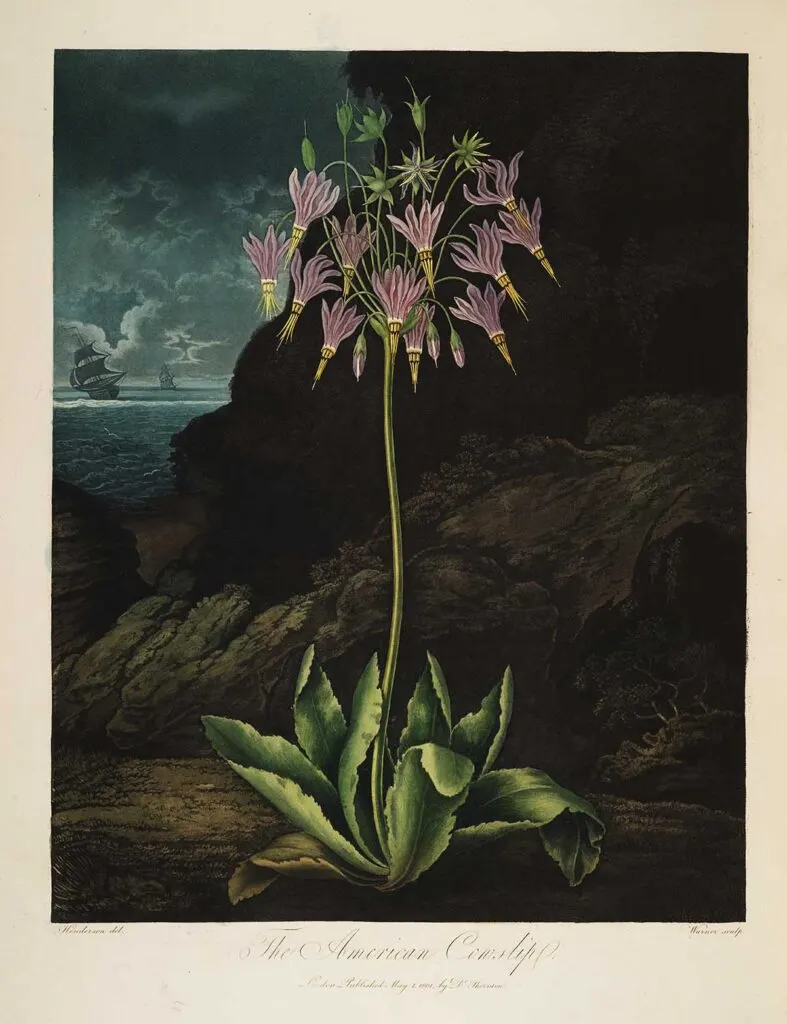
23. Narrow Leaved Kalmia
“This beautiful shrub was introduced into our gardens from North America by Peter Collinson, Esq. in 1T36. It grows to two feet in height and sends out several upright branches, which are beset with flowers like a cluster of bees. Each flower is rotated, and possesses a pistillum in the centre, surrounded by ten males, or stamina“.
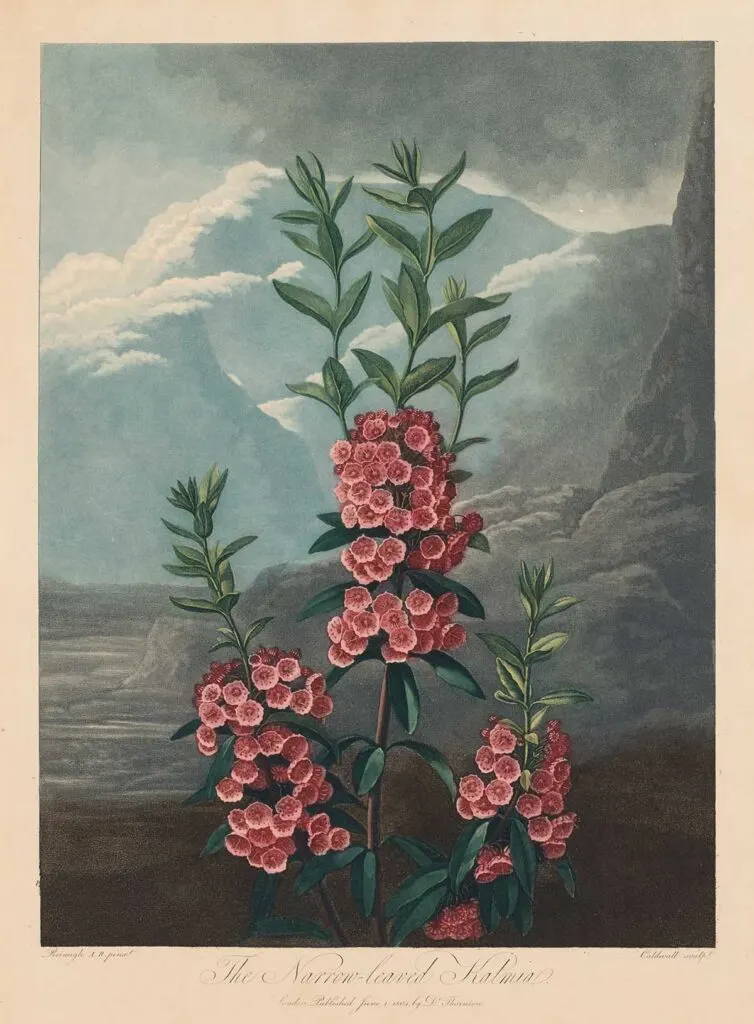
24. Indian Reed
“This beautiful plant is native to warm climates, and was early introduced into our gardens, even as far back as the time of Gerard, who mentions it as growing in his garden in 1596.”
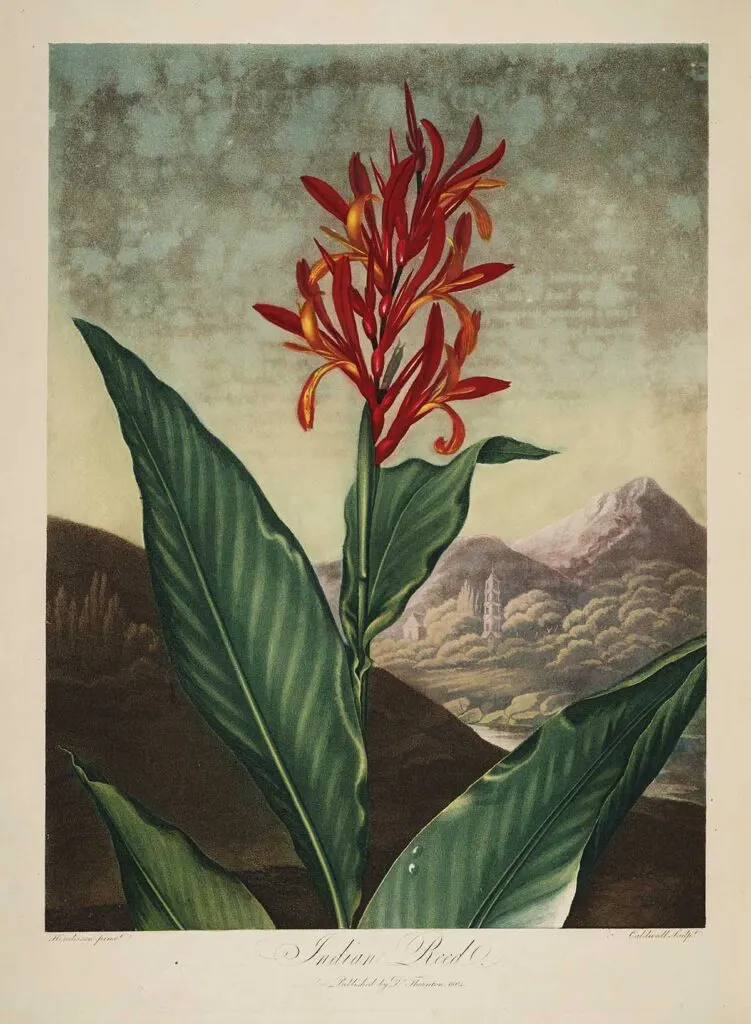
25. Sacred Egyptian Bean
“In hot climates, where water is the best boon of Heaven, flourish the several kinds of Nymphaeas. These present the purest colours, and are of an azure blue, or blushing red, or pale yellow, the three primary colours, and also of a dazzling white, all which majestically, (different from our humble aquatics), rise with their foliage above the surface of the flood, and present their luxuriant leaves to the vaulted heaven.“
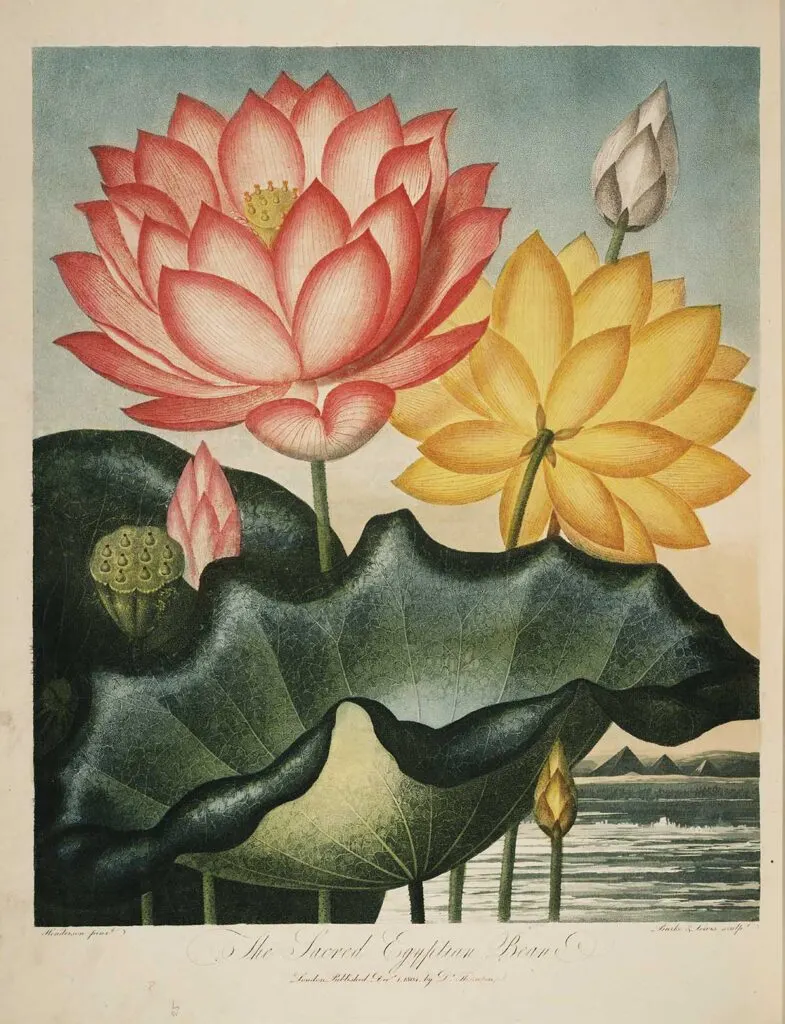
26. Blue Egyptian Water Lily
“In our Picturesque Plate, we have introduced a distant view of Aboukir, and the waters of the Nile, where the Blue Lotus is found in great abundance, and which tends much to enliven the scene. As the flood subsides, its tuberous roots afford a nourishment nearly resembling our Potato, but more mealy.“
There are some vintage giant water lily images on Pictureboxblue too!.
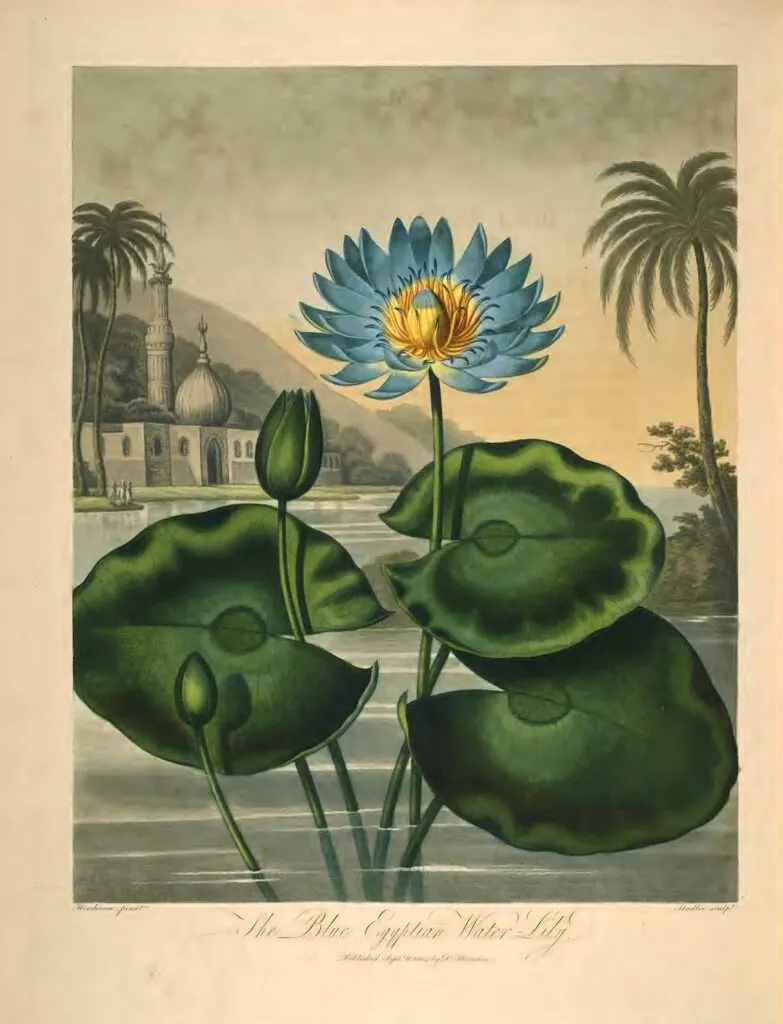
27. Artichoke Silver Tree
“This shrub is one of the most beautiful plants, which are to be found at the Cape of Good Hope, a country so extremely rich in vegetable productions. At a distance is represented by us the two celebrated mountains, one of which is called Table-Bay, from the flatness of the top, covered like a table with verdure, and possessing a piece of fine clear water, even at that stupendous height.”
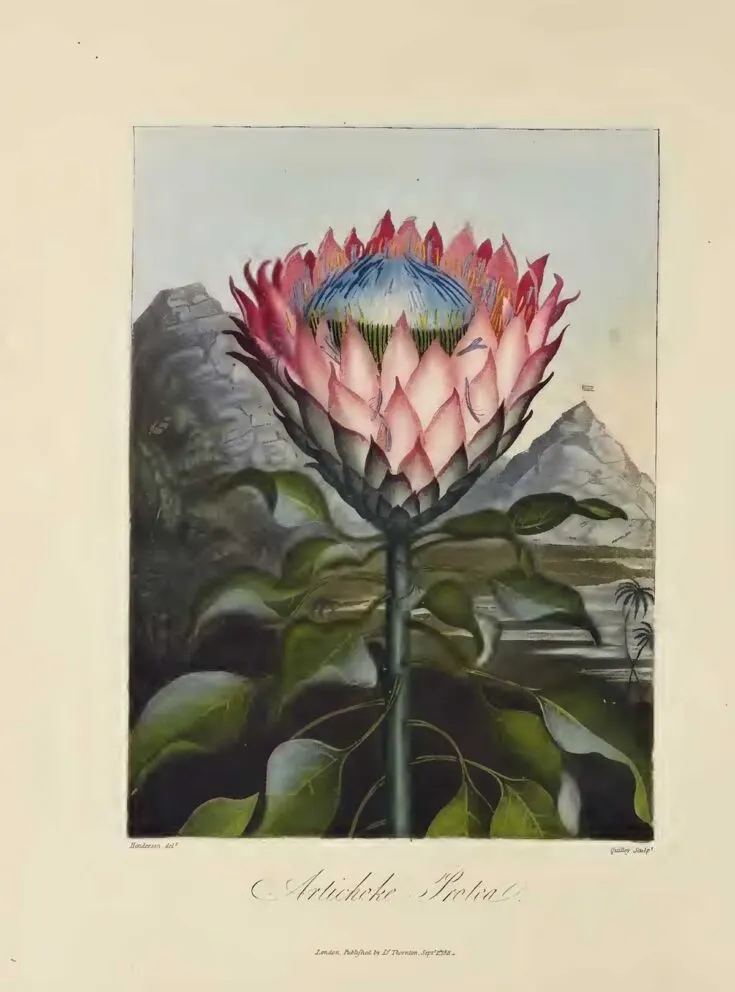
If you loved these vintage flora illustrations from the Temple of Flora check out some of my other print collections from famous antique natural history books.
- Tropical Botanical Illustration of John Lindley
- Orchid Prints of Charles Lemaire
- James Sowerby’s Mushrooms
- Pierre-Joseph Redoute’s flowers
- Adolphe Millot’s Botanicals
- Wild flowers of The British Isles
If you fancy, you can Buy Me A Coffee Here.

Kristine Huggins
Tuesday 6th of August 2024
Such beautiful images! Thank you so so so much for sharing these absolutely gems!
claire
Tuesday 6th of August 2024
Thank you are welcome
Christine Laing
Wednesday 25th of January 2023
I collect vintage floral prints and these are the most beautiful vintage florals I have ever seen. Thank you for sharing them and also the story of the artist.
claire
Thursday 26th of January 2023
Thank you, are welcome, glad you enjoyed them.
Rebecca
Tuesday 31st of May 2022
I ALWAYS LOOK FORWARD TO YOUR VINTAGE PRINTS. THANK YOU
claire
Tuesday 31st of May 2022
That's lovely to hear, thank you.